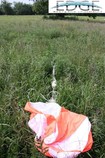Pick a Parachute ($50-$120)
Like the balloon mass, selecting the right payload is dependent on the weight of your payload. You shouldn't need any more than an eight-foot parachute unless you're planning on doing a fair bit of paperwork with the FAA. There are three major options here, all from high-powered rocket supply shops. Generally, you want to pick a parachute that advertises a descent rate of no more than 20 ft/sec (1200 ft/min) for your given payload weight. Slower is more gentle, but will drift farther in the wind on descent; 1000-1200 ft/min is what the Edge team aims for.
Spherical chutes are the most commonly used parachutes for high-altitude balloons, and exhibit good stability during descent due to the vent hole at the top of the chute. Unfortunately, spherical
chutes generally use a spreader ring (a lightweight ring usually about 10-20% of the chute diameter to which the shroud lines are attached) to help with parachute inflation (makes setup more
complex). Additionally, they are prone to tangling with latex shreds (leads to much faster descents when it happens). However, they've been around for ever and are routinely used by teams
launching in all kinds of weather. These parachutes are available from Spherachutes.
Elliptical chutes are less common, but offer the greatest amount of drag for the diameter possible. They exhibit slightly better stability than spherical chutes (depending on who you ask), but have the same drawbacks (spreader rings and tangles). The best supplier that I've found for elliptical chutes is Fuity Chutes (look for the Classic Elliptical and L3 Elliptical).
Our current parachute of choice is from The Rocketman. It's difficult to classify this parachute, but it looks a little
bit like a drogue chute without the restriction on the air inlet. The major benefit to this chute is that it only has four shroud lines, so it's far less prone to tangling, and it doesn't require a
spreader ring at all. Additionally, it's possible to reduce the effective size of the chute by sliding the choke up the shroud lines, so that a larger chute can handle a lighter payload (or bring a
heaver one down faster). The only real drawback is that it dumps air out of its sides, which leads to less stability on the way down than would be experienced with a spherical or elliptical chute. In
my experience, this isn't an issue, and the EDGE2 video on our site was taken under a rocketman chute (note the behavior on descent).
Note that the color of your parachute is important. In the picture above, the parachute (in this case a spherical chute with orange and white panels) definitely helped the team find the payload in the tall grass.



